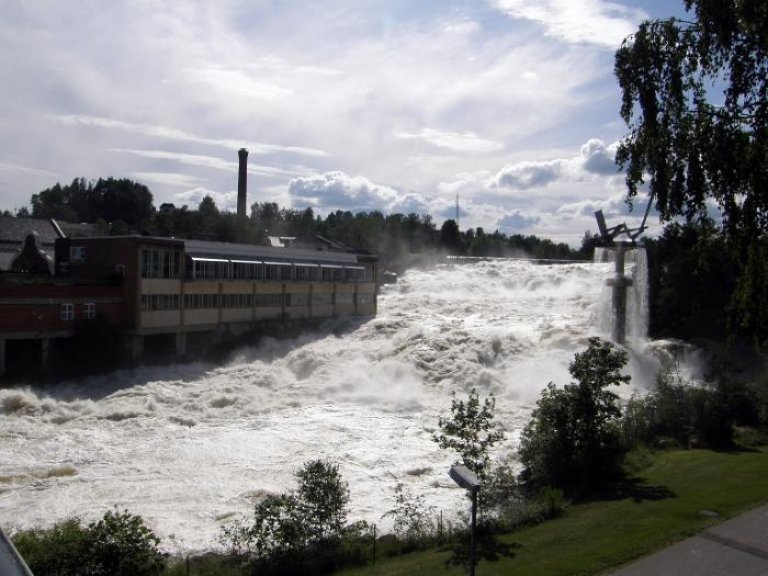
Climate adaption of water management
Several of the EU directives have been implemented in Norway, although the country is not a member of the EU. One of these directives is the EU Water Framework Directive, whose goal is to make a comprehensive and integrated management of the water resources. Focusing mainly on pollution and water ecology, the directive was developed in the 90s and entered force in 2000. Challenges regarding climate change, and how climate change influence the water masses and timing of floods, were not addressed at that time.
- Many of the consequences of a changed climate concerns water in one way or another, and there is a need to adapt the water management to climate change, says Line Barkved, researcher at The Norwegian Institute for Water Research, NIVA.
Clear signals and strict demands
Climate change adaptations are not a part of the EU Water Framework Directive, but the EU now requires that climate change and climate change adaptation must be integrated in all future management plans that are subject to the directive. This is in concordance with the latest IPCC report, in which the need for the society to adapt to climate change is especially highlighted.
In Norway, the Water Directive is implemented in the water regulation. The water regulation divides Norway into eleven regions that each has its own water management plan. The time span for the plans are long, built up of three twelve-year periods, each period consisting of a six-year planning phase and a six-year implementation phase. Norway is currently in the first six-year phase in which management plans are made for all eleven regions.
One of the topics which the research collaboration centre CIENS focuses on, is how climate change and climate change adaptation can be integrated in the society and in management plans. A previous study by the Norwegian Institute for Urban and Regional Research (NIBR) and NIVA, researchers Gro Sandkjær Hanssen, Silje Holen, Jan Erling Klausen and Barkved revealed that climate change adaptation was not a major topic in the latest water management plans.
Regional differences
As part of the study, the researchers made questionnaires to the committees for the different water regions. One of the questions was: “Has climate change been discussed as part of the work with the water regulation?”The questionnaire was answered in 2013, and the results revealed big regional differences between Northern and Southern Norway.
- In the regions in Southern Norway, there was a considerably higher percentage reporting that climate change had actually been discussed during the work with the water regulation, Barkved explains.
- Experiences with heavy precipitation in these regions might explain some of the differences.
As seen from the table, 92 percent of the members in Agder water region report that climate change had been discussed, while 90 percent in Rogaland water region report the same. Vest-Viken and Glomma water regions follow, both at 79 percent. The four regions in Western Norway – Hordaland, Sogn og Fjordane, and Møre og Romsdal – have a score between 64 and 77 percent, while the regions in Northern Norway have the lowest scores.
Few details
In 2014, The Norwegian Environment Agency examined the discussion documents from the water management plans and planned measures to be taken. They concluded that although most of the management plans mentioned climate change as a challenge, details about how the changes would influence future distributions of water, or measures in the regions, were not assessed.

New guidelines
The Environment Agency called for better guidelines for the water managers. Line Barkved and Gro Sandkjær Hanssen were assigned for the task and did a pilot study.
- The purpose of the pilot study was to map the needs and possibilities being relevant for the management guideline that the Agency plan to develop within 2017, Barkved says.
Methods and data for the pilot study have been national and international scientific literature, the earlier mentioned questionnaire, conversations with key persons, and internal meetings.
Combining societal security and aquatic environment
The guidelines should give information about what kind of knowledge and which data are necessary to do the relevant evaluations regarding climate adaptations. A clear division of responsibilities and roles are also requested by water region coordinators and local project leaders.
- Feedback from those who will use the guidelines have been important, says Barkved and explains:
-Feedback from the local and regional coordinates about the limitations they experience regarding time and resources is especially helpful.
- There is a clear message in the feedback we got; the guidelines must be adjusted for practical use.
Climate change and – adaptation will influence both the aquatic environment and the need for measures both positively and negatively.
- The measures must be robust to climate change, Barkved points out.
- Additionaly, societal security should be considered together with the aquatic environment, for instance by prioritizing preventive measures rather than measures that reduce the damage – plus focus on good land use planning.
From Glomma to Greece
Greece will also benefit from the experiences gained in this project. In a new cooperation project financed by EEA, one of the main goals is to compare how Greece and Norway work to adapt the water management to climate change. Crete is the Greek base for the research on water management.
- Experience from national NIVA projects, like the Glomma project, will be compared with the water management at Crete.This comparison will give interesting results on the European level, as Norway/Glomma and Greece/Crete are as far apart as possible in today´s Europe, both economically and regarding the water challenges they face -but both countries have obligations towards the same EU Water Framework Directive, Line Barkved concludes.